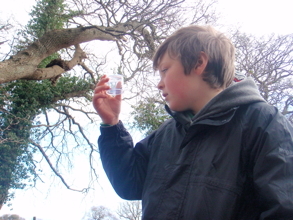Collecting Minibeasts
 Many minibeasts either hibernate or spend the winter as eggs or pupae, so the best time of year to go out and study these creatures is when the weather is warm, from late spring into the summer. Minibeasts, particularly insects, can be found almost anywhere. You will be able to observe butterflies, bees, wasps, other small insects and some spiders simply by watching patches of flowering plants in the garden. If you can see a minibeast clearly, don’t try to catch it. Remember that bees and wasps can sting! Always put caterpillars back on the plant that you found them on.
Many minibeasts either hibernate or spend the winter as eggs or pupae, so the best time of year to go out and study these creatures is when the weather is warm, from late spring into the summer. Minibeasts, particularly insects, can be found almost anywhere. You will be able to observe butterflies, bees, wasps, other small insects and some spiders simply by watching patches of flowering plants in the garden. If you can see a minibeast clearly, don’t try to catch it. Remember that bees and wasps can sting! Always put caterpillars back on the plant that you found them on.
See how many minibeasts you can find in the leaves of a tree by holding a large white sheet under the lowest branches and giving them a good shake. Among the creatures that fall onto your sheet you may find beetles, spiders, lacewings, gall wasps, fruit flies, weevils and green caterpillars.
A pond is another good minibeast habitat and the best way to find out about the minibeasts in a pond is to arm yourself with a net, a large bowl or shallow tray, a magnifying glass and a notebook and go pond dipping. Remember to return all the animals to the water when you have finished.
The dark, damp conditions underneath a rotting log attract slugs, beetles, centipedes, millipedes, woodlice and a host of smaller minibeasts. Carefully roll aside a log to search for these creatures – but be sure to replace the log exactly where you found it to avoid destroying their micro-habitat.
Try setting traps for slugs in the garden. These molluscs need moisture so they prefer dark, damp places. Experiment with different types of traps which create these conditions – perhaps half a grapefruit skin (open side placed downwards), a sheet of black plastic or a flat piece of wood. Place the traps near some plants, preferably leafy vegetables, on a warm, wet day and leave them overnight. Examine the traps the next morning and see which one was the most successful. The slugs may try to eat the inside of the grapefruit skin. Other nocturnal, damp-loving minibeasts may be attracted to your traps too.
Read More: Looking Closely at Minibeasts in Leaf Litter